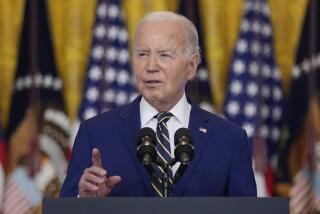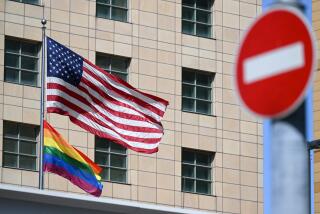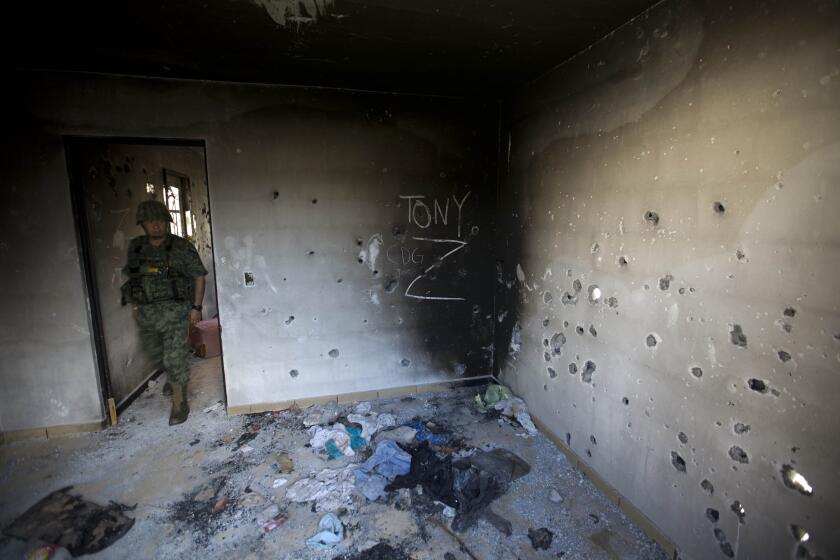Gays in Armed Forces Would Still Confront Minefield of Regulations : Military: If the ban is lifted, the real battle will be over how to redraft a maze of rules covering a soldier’s behavior--on duty and off.
WASHINGTON — President Clinton’s new compromise on lifting the ban against homosexuals in the U.S. armed forces technically has won him a six-month truce in his battle with Congress and the military.
Now comes the trench warfare: drafting the detailed regulations that will be needed to shape--and carry out--the new executive order the President has said he plans to issue in six months.
Lawyers on both sides agree that simply lifting the current ban will not be difficult legally. Clinton will merely have to rescind three existing executive orders dating from the early 1980s--all easily done with the stroke of a pen.
The real challenge will be in how to achieve the President’s goal of permitting gay soldiers to serve in the armed forces while at the same time restricting openly homosexual behavior among military personnel, as he has acknowledged must be done.
The battleground will be over replacing or amending the plethora of military directives, regulations and guidelines now in force, covering everything from how a soldier dresses to socially acceptable behavior for those in uniform.
Moreover, many experts believe that the new regulations will have to be crafted so the same standards apply both to gays and to heterosexuals--so that holding hands in public, for example, is off-limits (or else is allowed) for both--and that they apply off-duty as well as on.
“This is what they’ll spend the next six months doing--deciding things like what constitutes a ‘public display of affection,’ ” says Lawrence J. Korb, the former assistant defense secretary who issued the 1980s regulations.
“That’s where the fight will be--over the right of privacy,” Korb says.
The mountain of regulations and guidelines that Clinton must attack has several layers. At the top is the 1951 Uniform Code of Military Justice, which contains the statutes and laws that define criminal behavior in the armed forces and prescribe how to deal with it.
Below that are the Defense Department directives. The three that were issued in the early 1980s declare that homosexuality is “incompatible” with military service and require the discharge of servicemen and women who admit that they are gay or who engage in homosexual acts.
Under these are the regulations issued by the individual services and top field commanders, sometimes buttressed--or weakened--by later rulings handed down by the services’ respective judge advocate-generals’ offices. And there are orders issued by lower-level commands as well.
Clinton has spoken several times about revising the military “code of conduct,” but legal experts say he probably is speaking broadly about the Uniform Code of Military Justice (UCMJ) and the Pentagon directives. The only “Code of Conduct” now in force is for Americans who are captured as prisoners of war.
Most experts believe Clinton will not have to alter the UCMJ, which only an act of Congress can change. The only part that relates to homosexuality--an article making sodomy a crime--applies to heterosexuals as well, and is rarely enforced.
The Defense Department directives can be replaced easily by Defense Secretary Les Aspin, simply by issuing new revised policies. Clinton already has suspended one of the three directives, which required that recruits be asked if they are homosexuals.
Experts say the tough part will be drafting the companion regulations to be issued by the individual services and field commands, governing the treatment and day-to-day conduct of service personnel.
The battle lines are forming. Sen. Sam Nunn (D-Ga.), the most powerful opponent of lifting the ban, has cited a spate of everyday situations which he contends military authorities will have to cope with.
Among the items on Nunn’s list are:
--How to house gay personnel--particularly in close quarters, such as aboard submarines. Should the military provide separate barracks and bathrooms, as it does for men and women? What about heterosexual soldiers who object to rooming and showering with gays?
--How to define improper sexual activity. Should gays be allowed to dance together--or even hold hands--in public? What constitutes sexual harassment? Should the rules be the same for gays as they are for heterosexuals?
--Should homosexual couples be given the same benefits that military spouses receive--such as housing and medical care and privileges at the post exchange? What about the new “joint assignment” program, which enables two-soldier couples to serve at the same post?
Cathy Gilberd, an attorney with the Military Law Task Force, which monitors developments in military justice, agrees that some of Nunn’s apprehensions--such as berthing on submarines--are legitimate issues that need to be addressed by both sides.
Others may not be that difficult to resolve. For example, Gilberd points out, current military regulations prohibit heterosexual couples from public displays of affection while one of them is in uniform, and these rules could apply to gays and lesbians as well.
“What you’re really talking about is a set of definitions of acceptable standards,” Gilberd says.
But Gilberd contends that other items on the opponents’ list--such as whether to provide dependents’ benefits to gay couples--are merely canards that provide little ground for worry in the real world.
For example, she points out, on issues such as marriage and dependents, the military traditionally has followed the rules set by state courts and legislatures--and to date, at least, none of them has formally recognized homosexual marriages.
Robin Kane, a spokesman for the National Gay and Lesbian Task Force, brands such issues “nothing besides a smoke screen,” and asserts that gay-rights groups will be pushing for a say in helping to draft the Pentagon’s new regulations.
“We expect to be part of the process that President Clinton talked about today,” she says.
But David F. Burrelli, a Congressional Research Service analyst who recently conducted a broad review of the military policy on gays, warns that Friday’s compromise leaves such issues--and many others--uncomfortably “murky” and may take a good deal of work to resolve.
Burrelli argues that while it is easy enough “in the abstract” to allow gays to serve in the military while continuing to restrict their behavior there, such distinctions “may prove difficult . . . in the complex realities of everyday life.”
In that connection, Eugene R. Fidell, a Washington-based military law specialist, contends the crucial question will be whether authorities will prosecute violations that occur when a homosexual soldier is off-duty as well as on.
“They’ll obviously have to sort that out,” he says. “And some period of study is sensible.”
Gays in the Military
Homosexuals were not always barred from serving in America’s armed forces. Here is a brief history:
BEFORE WORLD WAR I, there were no regulations barring gays. Commanding officers were permitted to assign homosexuals to non-combat jobs, but few gay soldiers were discharged.
DURING WORLD WAR II, military psychiatrists labeled homosexuality a mental illness and tried to treat it. Those who failed to “improve” often were discharged for “inaptness or undesirable habits.”
IN THE LATE 1940s, as the Cold War intensified, gays were denied security clearances--ostensibly because they were vulnerable to blackmail. In 1947, the military began discharging soldiers deemed to have “homosexual tendencies.” Those who committed homosexual acts were subject to court-martial or administrative discharge.
IN 1951, the new Uniform Code of Military Justice made sodomy a criminal offense. The Army began discharging homosexuals.
IN 1966, the Army required that gay soldiers undergo psychiatric examinations before separation from the service.
IN THE LATE 1970s, in the face of growing court challenges to its practices, the military began reviewing its policies--but did not necessarily rule in favor of homosexuals’ rights.
IN THE EARLY 1980s, the Defense Department issued new directives declaring homosexuality to be “incompatible with military service” and ordered gays and lesbians discharged. It also required that recruits be asked whether they were homosexuals.
IN 1988, a landmark Pentagon study recommended lifting the ban on homosexuals. The document reviewed dozens of cases in which military personnel had compromised military secrets, and found that none of those who had been caught doing so was gay.
SINCE THEN, the courts have been chipping away at the ban. On Thursday, a U.S. District Court judge declared the ban on gays to be unconstitutional. President Clinton on Friday partially lifted the ban, delaying full repeal for at least six months during which time Congress plans lengthy hearings on the issue.
Source: Senate Armed Services Committee, Congressional Research Service
More to Read
Sign up for Essential California
The most important California stories and recommendations in your inbox every morning.
You may occasionally receive promotional content from the Los Angeles Times.










